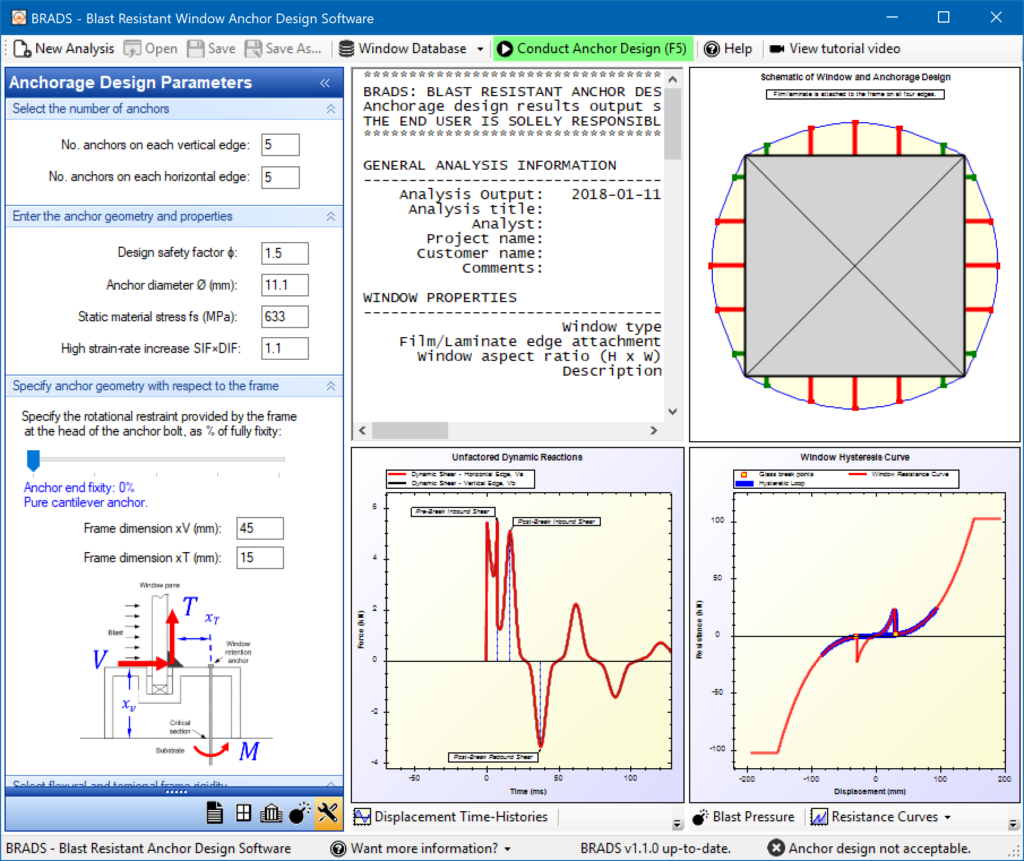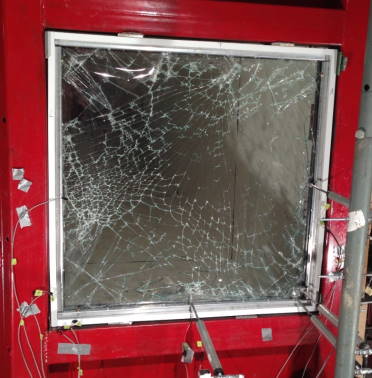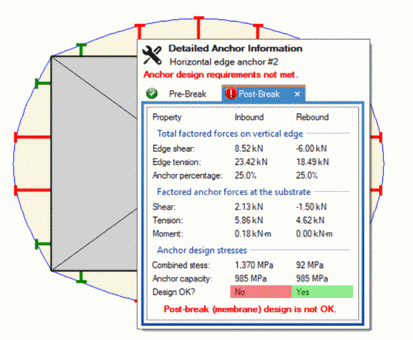BRADS
Blast Resistant Anchor Design Software
Blast-Resistant Window Anchor Design Software (BRADS) is a Windows®-based tool for the analysis and design of anchoring systems used in blast-resistant window glazing. The software is intended to aid engineers, architects, and manufacturers to enhance the resilience of critical infrastructure against terrorist bomb attacks and industrial explosions.
Methodology Overview
Computer software BRADS was developed at the University of Ottawa for conducting two-degree-of-freedom (TDOF) analysis and window anchor design. The algorithm underlying the software was developed to satisfy the requirements of CSA S852 , the new Canadian standard for Blast Resistant Window Anchor Systems. The tool can compute the required configuration of window retention anchors based on the major parameters known to influence anchorage capacity, including: substrate flexibility, glazing response, window aspect ratio, frame rigidity, the distribution of dynamic reactions, combined stresses, and anchor boundary conditions.

Two-Degree-of-Freedom Analysis
The window/substrate assembly in the software is subjected to total blast loads, including the loads applied on the substrate. Substrate geometry and material properties are specified. The user can select one of three pre-defined elastic substrates (concrete, masonry, or steel), or can specify a custom nonlinear mass-spring-damper element for the substrate. The dynamic properties of the window system, such as resistance, mass, and damping, are stored in a database within the software and are specified from a drop-down menu. The software includes dynamic properties for window systems commonly used in the blast-resistant construction industry. New windows can be added to the database to expand the functionality of the software by entering the properties of a specific window system. These properties may be obtained from protective window design software, hand calculation, finite element analysis, or from experimental tests. The blast loads used in anchorage design can consist of either: i) an impulsive pressure-time function with triangular idealization; ii) an exponential-decay pressure-time history defined using the TNT charge mass and stand-off distance; or, iii) as a series piecewise pressure-time history points entered by the user. The software conducts TDOF analysis and computes maximum displacements for the substrate and the window. If the analysis predicts that the window achieves a stable equilibrium, indicating window failure has not occurred, the software calculates window edge support reactions distributed around the window perimeter. The automated analysis procedure will evaluate dynamic reactions generated during the pre-break and post-break phases, and consider the possibility of load reversal, when determining design anchorage forces during inbound and rebound response.

Graphical User Interface
A graphical user interface (GUI) was developed to stream-line the analysis process. All parameters used in the solution of the dynamic equation of motion may be modified by the user within the GUI. Results are plotted on the screen, and program outputs are also made readily available for iteration design manipulations. If the required anchor capacity is higher than the applied design forces, then a green anchor symbol is displayed on the anchorage design plot at the specific location for which the design calculations are done. Otherwise a red anchor symbol is displayed. By clicking on individual anchors, the user can display design forces and capacities
The output consists of a printed design report that can be exported as an electronic file outlining the design data, analysis results in terms of substrate and window displacements, anchor shear, axial tension and bending moment values, as well as anchor capacities. The output is also available in a graphical format, displaying displacement time histories, resistance functions and the distribution of anchor forces with applied loads and capacities.

Anchorage Design
The number of anchors, diameter, strength, and geometry relative to the frame are input parameters. The software checks the capacity of each anchor and indicates whether it meets the requirement of capacity exceeding the applied load. The capacity check is done under combined stresses. A colour-coded graphical output consisting of the window and anchors is presented, with a green anchor indicating sufficient capacity, and red indicating a need for either increasing anchor size, reducing anchor spacing, or selecting an anchor with greater material capacity. This enables the designer to have full control over the design process.
Download BRADS
The BRADS system requirements are as follows:
- .NET Framework 4.5.2
- Windows XP or greater
- 1Ghz CPU & 512 MB RAM
- 30 MB hard disk space